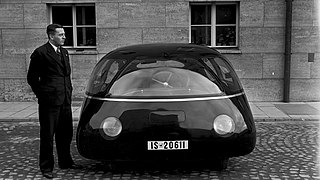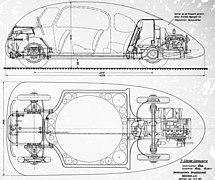Schlörwagen

The experimental vehicle Schlörwagen (also " Göttinger Egg" or "Wings on Wheels") was a development by the German engineer Karl Schlör von Westhofen-Dirmstein (1911–1997). The 1939 at the Aerodynamic Research Institute (AVA) in Göttingen developed prototype with a body made of aluminum was long considered consistent implementation of aerodynamics in the vehicle he was in the measurements to its Windschlüpfigkeit a drag coefficient (C w value) of 0.186. During follow-up measurements in the 1970s, Volkswagen technicians determined a C w value of 0.15 using a model of the Schlörwagens . The design of the streamlined car was based on the shape of aircraft wings and was geared towards minimal fuel consumption, with seven seats the car should also serve as a spacious family vehicle. Today's cars with a C w value of 0.24 to 0.3 do not come close to this design: only more modern experimental cars such as the “ 1-liter car ” from VW or the “ Fennek ” from Graz University of Technology have lower Cw values on.
The Schlörwagen was mounted on a modified chassis of the Mercedes 170 H . The wheelbase was 2.60 meters, the vehicle was 4.33 meters long and 1.48 meters high. The width of 2.10 meters was necessary to let the wheels run inside the body. The body , produced by a company in Essen, was teardrop-shaped, had flush windows with curved panes and a closed floor. However, despite the aluminum structure, it was about 250 kg heavier than that of the Mercedes 170H; its aerodynamic shape and the center of gravity, which is far to the rear due to the rear engine, impaired the driving safety of the Schlörwagens and made it very susceptible to cross winds .
In a test drive with a Mercedes 170H series vehicle as a comparison model, the Schlörwagen was 20 km / h faster than the Mercedes with a top speed of around 135 km / h and, with 8 liters of petrol per 100 kilometers, consumed between 20 and 40 percent less fuel than the comparison vehicle, the was 10 to 12 liters. According to Karl Schlör, the vehicle should even have driven at 146 km / h during one trip, but this is not considered proven. With these values, the car caused a stir at the 1939 IAA in Berlin, but was perceived by the public as ugly.
In 1942, the rear of the Schlörwagen was equipped with a Soviet propeller drive with a 130 hp (96 kW) radial engine captured in World War II , and it was used for test drives in Göttingen. The prototype of the car was last after the end of the Second World War until August 1948 on the grounds of the German Aerospace Center (DLR) in Göttingen. Attempts by Schlörs to get the badly damaged body from the British military administration failed. Her whereabouts have since remained unclear.
On the occasion of the 100th anniversary of the DLR in 2007, it placed a preserved, scaled-down original model in a wind tunnel: It did not show any stalling or turbulence that would slow the way . Also, producing no increased air resistance , the long, drawn-down tail seemed ideal.
A 1: 5 scale replica based on the original drawings stored in the DLR archive can now be viewed in the “ PS-Speicher ” in Einbeck .
gallery
Construction drawings ("7-seater sedan ")
Driver's seat, dashboard and steering wheel
Test drive on the predecessor of today's A 7 motorway near Göttingen (1939)
German Aerospace Center (DLR): Schlörwagen model in the wind tunnel
Web links
- DLR portal: DLR researcher unravels the secret of the most streamlined family car in automotive history ( Memento from June 18, 2009 in the Internet Archive )
- Podcast of the Helmholtz Society : helmholtz.de: "Göttinger Ei" (MP3; 2.9 MB)
- nast-sonderfahrzeuge.de: Press release by "Prototyp GmbH" on the special exhibition "100 Years Against the Wind"






